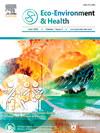中国551个城市学龄前儿童的早期生活环境与睡眠障碍
IF 17.6
引用次数: 0
摘要
儿童早期居住环境与睡眠健康之间的关系仍未得到充分研究。本研究调查了来自中国551个城市的101879名学龄前儿童早期接触绿色环境与睡眠结果的关系。使用儿童睡眠习惯问卷(CSHQ)评估睡眠状况。利用卫星衍生的归一化植被指数(NDVI)和增强植被指数(EVI)估算了参与者家周围孕期和产后的绿化程度。使用线性混合效应和随机效应logistic回归模型分别评估绿化与CSHQ评分和睡眠障碍的关系。考察了空气污染与居民与主要道路距离的中介效应。产前和产后接触绿色环境与更好的睡眠结果显著相关。具体而言,在整个怀孕期间和从出生到调查期间,250 m缓冲区内NDVI的四分位数范围内增加分别与CSHQ总分降低0.21(95%可信区间[CI]: 0.14, 0.28)和0.22 (95% CI: 0.15, 0.29)相关。两个时期睡眠障碍的相应优势比为0.96 (95% CI: 0.94, 0.98)。当考虑更大的缓冲区(500米和1000米),并采用EVI和生长季节NDVI等其他绿色指标时,这些关联仍然是一致的。PM2.5、住宅与主要道路的距离、NO2和SO2在一定程度上介导了出生后绿色暴露与睡眠障碍的关系。生活在中国北方、母乳喂养6个月或母亲受教育程度较高的儿童从绿化中受益更大。早期接触更多的绿色环境似乎对儿童睡眠健康有积极影响。本文章由计算机程序翻译,如有差异,请以英文原文为准。

Early-life residential greenness and sleep disturbances in preschoolers across 551 cities of China
The nexus between early-life residential greenness and sleep health in children remains underexplored. This research investigated associations of early-life greenness exposure with sleep outcomes among 101,879 preschoolers from 551 Chinese cities. Sleep status was evaluated using the Children's Sleep Habits Questionnaire (CSHQ). Greenness was estimated using satellite-derived Normalized Difference Vegetation Index (NDVI) and Enhanced Vegetation Index (EVI) surrounding participants' home during pregnancy and post-birth period. Linear mixed-effect and random-effects logistic regression models were used to assess associations of greenness with CSHQ scores and sleep disturbance, respectively. Mediation effects of air pollution and residential distance to major roads were examined. Both prenatal and postnatal greenness exposures were significantly associated with better sleep outcomes. Specifically, an interquartile range increment in NDVI within the 250-m buffer during the entire pregnancy and from birth to investigation was associated with reductions in the total CSHQ score by 0.21 (95% confidence interval [CI]: 0.14, 0.28) and 0.22 (95% CI: 0.15, 0.29), respectively. Corresponding odds ratios for sleep disturbance were 0.96 (95% CI: 0.94, 0.98) for both periods. These associations remained consistent when considering larger buffers (500-m and 1000-m), and employing other greenness metrics like EVI and growing-season NDVI. The association between postnatal greenness exposure and sleep disturbance was partially mediated by PM2.5, residential distance to major roads, NO2, and SO2. Children living in Northern China, breastfed for <6 months, or with more educated mothers showed greater benefits from greenness. Increased early-life greenness exposure appears to positively influence childhood sleep health.
求助全文
通过发布文献求助,成功后即可免费获取论文全文。
去求助
来源期刊

Eco-Environment & Health
环境科学与生态学-生态、环境与健康
CiteScore
11.00
自引率
0.00%
发文量
18
审稿时长
22 days
期刊介绍:
Eco-Environment & Health (EEH) is an international and multidisciplinary peer-reviewed journal designed for publications on the frontiers of the ecology, environment and health as well as their related disciplines. EEH focuses on the concept of “One Health” to promote green and sustainable development, dealing with the interactions among ecology, environment and health, and the underlying mechanisms and interventions. Our mission is to be one of the most important flagship journals in the field of environmental health.
Scopes
EEH covers a variety of research areas, including but not limited to ecology and biodiversity conservation, environmental behaviors and bioprocesses of emerging contaminants, human exposure and health effects, and evaluation, management and regulation of environmental risks. The key topics of EEH include:
1) Ecology and Biodiversity Conservation
Biodiversity
Ecological restoration
Ecological safety
Protected area
2) Environmental and Biological Fate of Emerging Contaminants
Environmental behaviors
Environmental processes
Environmental microbiology
3) Human Exposure and Health Effects
Environmental toxicology
Environmental epidemiology
Environmental health risk
Food safety
4) Evaluation, Management and Regulation of Environmental Risks
Chemical safety
Environmental policy
Health policy
Health economics
Environmental remediation
 求助内容:
求助内容: 应助结果提醒方式:
应助结果提醒方式:


